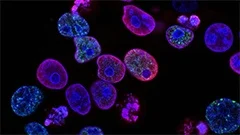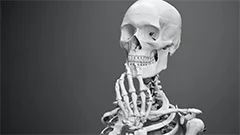Introduction
The extracellular matrix (ECM) is a complex network of biomolecules secreted by cells that provides structural support, regulates cell behavior, and facilitates tissue organization. This lecture aims to provide an in-depth understanding of the ECM, its components, functions, and the role it plays in various biological processes.
Definitions and Importance
The ECM is a dynamic non-cellular component that surrounds cells and tissues in multicellular organisms. It acts as a scaffold for cells, helping them maintain their shape and function correctly. Furthermore, the ECM serves as a reservoir for various signaling molecules, affecting cell behavior, proliferation, differentiation, and migration.
Structure of the Extracellular Matrix
The ECM's Main Components
- Proteoglycans: Protein-polysaccharide complexes that can bind water molecules, thus contributing to tissue hydration and providing structural support.
- Collagens: Fibrous proteins responsible for maintaining the strength and integrity of the ECM in various tissues such as tendons, ligaments, and skin.
- Glycosaminoglycans (GAGs): Long unbranched polysaccharides consisting of repeating disaccharide units with a specific sequence of sugar residues. They are essential for the hydration and electrostatic interactions in the ECM.
- Fibronectin: A large, multidomain protein that plays a crucial role in cell adhesion, migration, and differentiation by binding to various ECM components and integrins on the cell surface.
- Laminins: Network-forming proteins essential for basement membrane formation, which provides structural support and separates epithelial cells from underlying tissues.
- Elastin: An elastic protein that allows tissues to stretch and recoil, thus contributing to tissue elasticity and resilience.
- Matrikines and growth factors: Small signaling molecules stored within the ECM that regulate cell behavior, proliferation, differentiation, and migration.
The Interplay of the Extracellular Matrix with Cells
- Cell Adhesion: The interaction between cells and the ECM involves integrins, a type of transmembrane protein found on the cell surface. Integrins bind to various ECM components, allowing for mechanical anchoring and signaling between the cell and its environment.
- Cell Migration: During development or tissue repair, cells need to move through the ECM. This process is regulated by the degradation of ECM components by matrix metalloproteinases (MMPs) and other enzymes, allowing for cell migration along a chemical gradient provided by chemoattractants in the ECM.
- Cell Proliferation: The ECM provides signals that influence cell proliferation rates. For example, high concentrations of collagen fibers can promote quiescence or senescence in cells, while lower concentrations may stimulate cell division.
- Differentiation: The ECM plays a crucial role in directing cell differentiation by providing specific signals that dictate the cell's fate. For example, bone morphogenetic proteins (BMPs) stored within the ECM can signal to cells to differentiate into osteoblasts and form bone tissue.
- Wound Healing: During wound healing, the ECM undergoes dramatic changes to facilitate tissue repair. The initial degradation of the ECM by MMPs allows for cell migration and proliferation, followed by the reorganization of the ECM to provide structural support and promote tissue regeneration.
- Cancer Progression: Alterations in the ECM can contribute to cancer progression by providing signals that promote tumor growth, invasion, and metastasis. For example, increased collagen fiber density and altered glycosaminoglycan composition may stimulate angiogenesis and provide a scaffold for tumor cells to migrate through.
Future Directions and Challenges
The study of the ECM has important implications for understanding various physiological processes, as well as in developing treatments for diseases such as cancer, fibrosis, and degenerative disorders. However, the complexity and dynamic nature of the ECM pose significant challenges in fully elucidating its role in these processes. Future research will focus on unraveling the intricacies of ECM-cell interactions, developing novel strategies for manipulating the ECM to treat diseases, and understanding the molecular mechanisms underlying ECM assembly and remodeling.
QCM : Teste tes connaissances !
Penses-tu tout connaître de ce cours ? Ne tombe pas dans les pièges, entraine-toi à l'aide des QCM ! eBiologie recense des centaines de questions pour t'aider à maîtriser ce sujet.
Pour aller plus loin...
Ces cours peuvent t'intéresser
Créez un compte gratuit pour recevoir des cours, QCM et des conseils pour réussir vos études !
eBiologie met à disposition plusieurs eBooks contenant des séries de QCM (5 fascicules offerts pour chaque inscrit).








